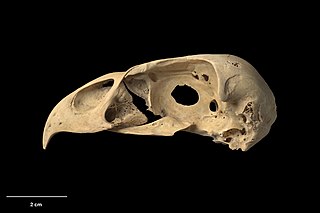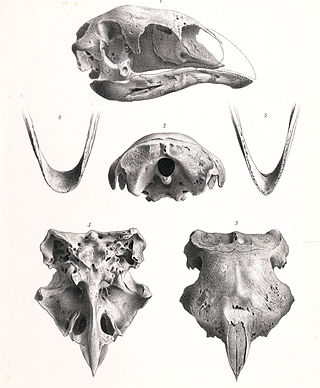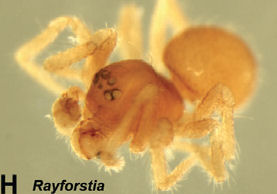
The New Zealand storm petrel is a small seabird of the family Oceanitidae endemic to New Zealand. Thought to be extinct since 1850, a series of sightings from 2003 to the present indicated the presence of a previously unknown colony. The population of New Zealand storm petrels has been estimated to be less than 2000.

The Auckland Island merganser, also known as the New Zealand merganser, was a typical merganser that is now extinct.

The bush moa, little bush moa, or lesser moa is an extinct species of moa from the family Emeidae endemic to New Zealand.

Eyles's harrier is an extinct bird of prey that was endemic to New Zealand.

The New Zealand quail, or koreke in Māori, is an extinct quail species endemic to New Zealand. The male and female were similar, except the female was lighter. The first scientist to describe it was Sir Joseph Banks when he visited New Zealand on James Cook's first voyage. Terrestrial and temperate, this species inhabited lowland tussock grassland and open fernlands. The first specimen to be obtained by a European was collected in 1827 by Jean René Constant Quoy and Joseph Paul Gaimard on Dumont D'Urville's voyage. It most likely went extinct due to diseases from introduced game birds.

Magnoteuthis is a genus of whip-lash squid containing at least three species. Some teuthologists consider Idioteuthis or Mastigoteuthis synonymous with this taxon, but it is genetically and morphologically distinct.

The broad-billed moa, stout-legged moa or coastal moa is an extinct species of moa that was endemic to New Zealand.

The New Zealand goose is a bird of the extinct genus Cnemiornis of the family Anatidae, subfamily Anserinae. The genus, endemic to New Zealand, consisted of two species: the North Island goose, C. gracilis and the South Island goose C. calcitrans.

The Chatham Island merganser is an extinct species of merganser duck from New Zealand. The binomial name refers to Dr. Philip Millener, to recognise his work in collecting material on the species.

Ichneutica seducta is a moth of the family Noctuidae. This species is endemic to New Zealand. It is found only in the Chatham Islands and inhabits native forest. The life history of this species is unknown but the larval host species is likely to be Dracophyllum arboreum. The adults of this species are on the wing from November to January and are attracted to light.

Cantuaria abdita is a species of trapdoor spider endemic to New Zealand.

Kapanga grana is a species of Dwarf sheet spider that is endemic to New Zealand

Tangata rakiura is a species of araneomorph spider of the genus Tangata. The species is endemic to New Zealand

Ascuta australis is a species of orsolobidae spider of the genus Ascuta. The species is endemic to New Zealand

Cytora rakiura is a species of very small land snail in the family Pupinidae. It is endemic to New Zealand.

Porrhothele quadrigyna is a species of Mygalomorphae spider endemic to New Zealand.
Rayforstia salmoni is a species of Anapidae that is endemic to New Zealand. The species was first described by Ray Forster in 1959.
Rayforstia propinqua is a species of Anapidae that is endemic to New Zealand. The species was first described by Ray Forster in 1959.

Rayforstia vulgaris is a species of Anapidae that is endemic to New Zealand. The species was first described by Ray Forster in 1959. It is also the type species for the genus Rayforstia.

Magnoteuthis magna is a species of squid in the genus Magnoteuthis. The species is widely distributed, and has been observed in the Gulf of Mexico, Indian Ocean, and off the coast of New Zealand. The species is commonly found in depths below 1,000 meters.


















